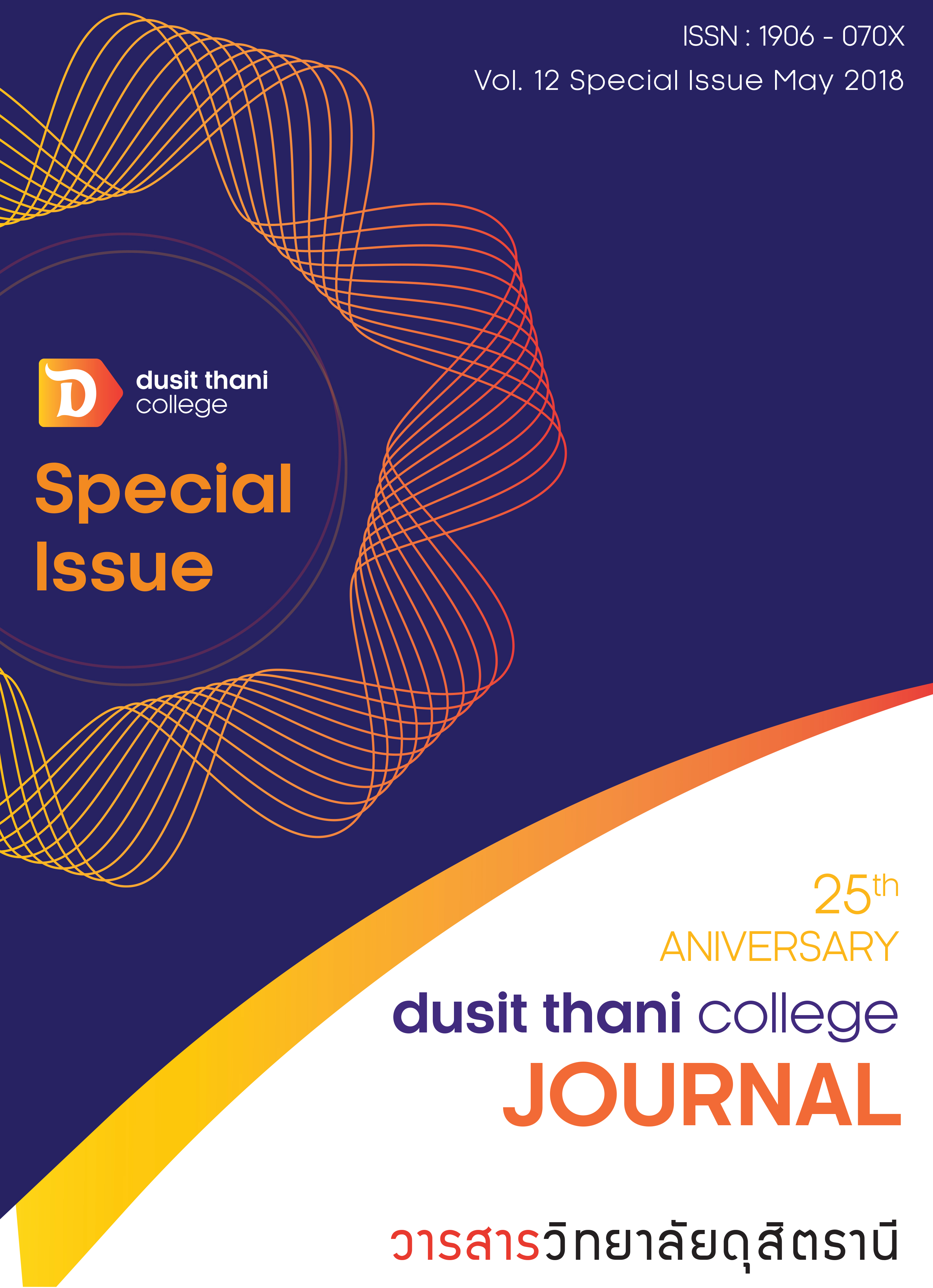Event Design Guidelines' for Cultural Fun Fair in Gracious Thai Hospitality: A Case Study of Dusit Thani College Bangkok
Main Article Content
Abstract
The purposes of this research were: 1) to study the concept of Gracious Thai hospitality 2) to prioritize classes in the domain design of EMBOK model for cultural fun fair. 3) to provide guideline for designing cultural fun fair in the context of Gracious Thai hospitality, A case study of Dusit Thani College, Bangkok. Qualitative research involving documentary analysis which was applied to obtain the data related to EMBOK model, concept of Thai Identity, Thainess and Gracious Hospitality. Qualitative data were collected from observation articipations, focus group discussions and In-depth interviews using Semi-structured interviews. A thematic analysis by offering descriptive analysis was used of this research. The finding indicated that “Gracious Thai hospitality” was A taking care of guests like a family members. Welcoming guests in traditional Thai greeting “Wai” in the “Thai smile” and said Thai hello “Sawasdee” with “humble”, “friendly”, “fun” and “helpful”. Respected seniority even though not a relative or a person known before. Always Thais said “Mai Pen Lai” it means “Don’t worry and Not Be Serious” to treat the spirit and maintain good relationships between people. Priority of classes of design domains are: Theme Design, Content Design, and Production Design respectively. The concept of Thai identity, Thainess and Gracious Hospitality was researched and applied to guideline of the event design for cultural fun fair, a creative work in designing and organizing the activities in accordance with this concept was provided such as “Thai Temple Fair”, “Come to Thai, Stays as Thais” and “Thailand's Street Food Culture”.
Article Details
Article Screening Policy
- All research and academic articles to be published must be considered and screened by three peer reviews in the relevant field / article.
- All articles, texts, illustrations and tables published in the journal are the personal opinions of the authors. Editors don't always have to agree. And no responsibility whatsoever is the sole responsibility of the author.
- The articles to be published must never be published. Where did you first publish? And not in the consideration of other journals If the audit found that there has been a duplicate publication It is the sole responsibility of the author.
- Any article that the reader sees as being plagiarized or impersonated without reference. Or mislead the work of the author Please let the journal editor know it will be your greatest blessing.
References
Ekman. P., &. F. (1971). Constants across cultures in the face and emotion. Journal of Personality and Social Psychology , 124-129.
Goldblatt J. (2014). Special Events: Creating and Sustaining a New World for Celebration 7th Edition. Wiley.
Hofstede, G. (1991). Cultures and organizations: Software of the mind. London: McGraw-Hill.
Hua Hin Today NEWS. (2016, May 30). A Gracious Greeting in Thailand. Retrieved from huahintoday.com: https://www.huahintoday.com/local-news/gracious-greeting-thailand/
Julia Rutherford Silvers. (2007). Analysis of the International EMBOK Model as a Classification System. Paper presented at the 2007 Las Vegas International Hospitality & Convention Summit .
Katja Pasanen & Eva-Maria Hakola. (2012). The Finnish Cultural Events: Characteristics, touristic significance and international potential. Centre for Tourism Studies, University of Eastern Finland.
Komin S. (1998). The world view through Thai value systems In A. Pongsapich (Ed.),(1998) Traditional and changing Thai world view (pp. 207-229). Bangkok. Bangkok: Chulalongkorn University Press.
Komin, S. ( 1990). Psychology of the Thai people: values and behavioral patterns . Bangkok, Thailand : Research Center, National Institute of Development Administration.
Kunawong, S. (2017). The business event : reduced the risk and increase revenue. acnews, p. https://www.acnews.net/detailnews.php?news_id=N256016006.
managernews. (2005, March 4). Story in Thailand: National Symbols of Thailand. Retrieved October 15, 2017, from www.manager.co.th: www.manager.co.th/Dhamma/viewnews.aspx?NewsID=9480000031590
Nartkosar, S. (2013). "A Reflection of Thai identity on decoration garden products". Silapakorn University, 67.
Nicole Ferdinand & Paul J. Kitchin. (2017). Event Design and Event Management. In Event Mangement : An International Apparch. London: SAGE Publications Ltd.
Noypayak, W. (2007). Value Dimensions of Thailand as Perceived by UK Tourists. Retrieved October 15, 2017, from www.tatjournal.com.
Phantpool, E. (2012). Thai Identity in Cherd Songsri’s films . Bangkok, Thailand: Chulalongkorn University.
quora.com. (2016, July 11). Retrieved from quora.com: https://www.quora.com/What-is-gracious-hospitality
S., Barme. (1993). Luang Wichit Wathakan and the creation of a Thai identity. Singapore: Singoutheast Asia Studies.
TAT NEWS. (2017, Oct 25). TAT previews “Open to the New Shades of Thailand” concept at ITB Asia 2017". Retrieved from tatnews.org: https://www.tatnews.org/tat-previews-open-new-shades-thailand-concept-itb-asia-2017/
tatpr. (2015). 2015 Discover Thaness Campaign. Retrieved from www.tatpr.org/.../Fact%20Sheet_2015%20Discover%20Thainess%20Fin
Thansettakij NEWS. (2017, October 20 - 22). Proudly Thai Identity - Thai Brand - Dusit International. Retrieved from thansettakij.com: www.thansettakij.com/content/181346
The Royal Society of Thailand. (2017). Dictionary: Thai Identity. Retrieved October 25, 2017, from www.royin.go.th/dictionary: www.royin.go.th
The Royal Society of Thailand. (n.d.). www.royin.go.th/dictionary. Retrieved October 25, 2017, from www.royin.go.th/dictionary
Tiranasar, A. (2004). Cultural Identity and Art Education in Thailand. Chulalongkorn University.
Wongtanasuporn, P. (2010). “Theoretical framework and components for embedding Thai identity , p.67. in A Design Strategy for Thai Village-based Manufacturer”. Swinburne University of Technology, Victoria, Australia.


